
- KPI – June 2025: The Brief
- KPI – June 2025: State of Manufacturing
- KPI – June 2025: State of Business – Automotive Industry
- KPI – June 2025: Consumer Trends
- KPI – June 2025: Recent Vehicle Recalls
In May, the Consumer Price Index for All Urban Consumers (CPI-U) increased 0.1% on a seasonally-adjusted basis following a 0.2% rise in April, according to the U.S. Bureau of Labor Statistics. Over the last 12 months, the all-items index increased 2.4% before seasonal adjustment.
Important Takeaways, Courtesy of the U.S. Bureau of Labor Statistics:
- The index for shelter rose 0.3% and was the primary factor in the all-items monthly increase. The food index increased 0.3% as both of its major components, the index for food-at-home and the index for food-away-from-home, increased 0.3% in May. In contrast, the energy index declined 1%.
- Indexes on the rise include medical care, motor vehicle insurance, household furnishings and operations, personal care and education. Among those to decrease were airline fares, used cars and trucks, new vehicles and apparel.
Overall, the all-items index rose 2.4% year-over-year, with the all-items less food and energy index increasing 2.8% over the last 12 months. The energy index decreased 3.5%, while the food index increased 2.9% over the last year.
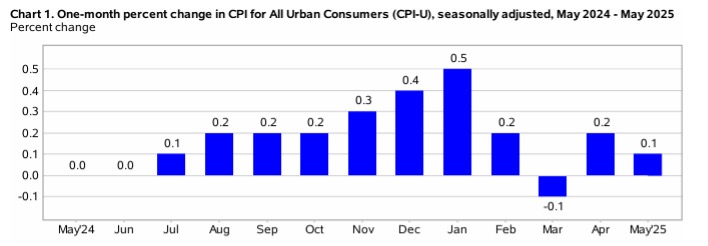
Employment
Total nonfarm payroll employment increased by 139,000 in May—above the Dow Jones estimate of 125,000 and slightly below the downwardly revised 147,000 in April. Employment continued to trend up in health care, leisure and hospitality and social assistance. Federal government continued to post job losses.
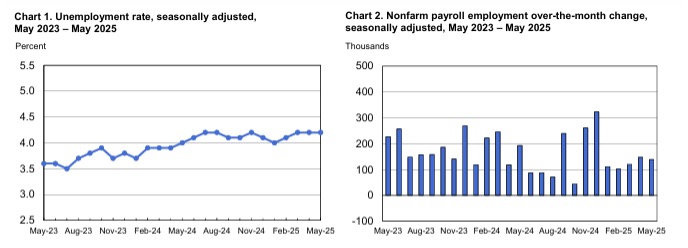
The unemployment rate and number of unemployed persons were unchanged at 4.2% and 7.2 million, respectively. According to the U.S. Bureau of Labor Statistics, the labor force participation and long-term unemployed (those jobless for 27 weeks or more) rates were 62.4% and 20.4% (-3.1% month-over-month), respectively.
In addition, worker pay grew more than expected, with average hourly earnings up 0.4% during the month and 3.9% from a year ago.
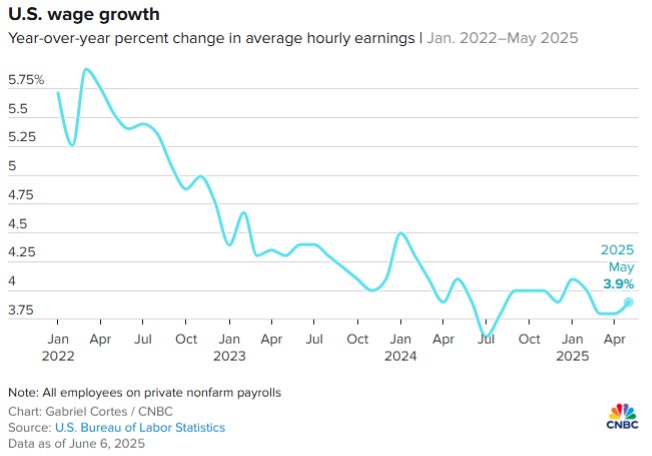
“Stronger than expected jobs growth and stable unemployment underlines the resilience of the U.S. labor market in the face of recent shocks,” says Lindsay Rosner, head of multi-sector fixed income investing at Goldman Sachs Asset Management.
Stock market futures jumped higher after the release, as did Treasury yields. On Friday, stocks increased as the U.S. moved closer to trade deals with China and other major trading partners (Dow +0.94%, S&P 500 +0.80% and Nasdaq +0.97%).
According to news reports, Federal Reserve officials are “viewing the current landscape with caution.” While Federal Reserve Chairman Jerome Powell recently told Congress the economy is in a “solid position,” with a stable unemployment rate and a labor market at or near maximum employment, the central bank is unwilling to lower interest rates at this moment.
Administration officials argue sour political motives, with Vice President JD Vance saying, “I’d love to hear an argument for why Powell cut rates 50 points right before [the 2024] election but can’t do it now with inflation [and other key conditions] lower.”
By Demographic
This month, unemployment rates among the major worker groups: adult women – 3.9%; adult men – 3.9%; teenagers – 13.4%; Asians – 3.6%; Whites – 3.8%; Hispanics – 5.1%; and Blacks – 6%.
Last month, unemployment rates among the major worker groups: adult women – 3.7%; adult men – 4%; teenagers – 12.9%; Asians – 3%; Whites – 3.8%; Hispanics – 5.2%; and Blacks – 6.3%.
![]()
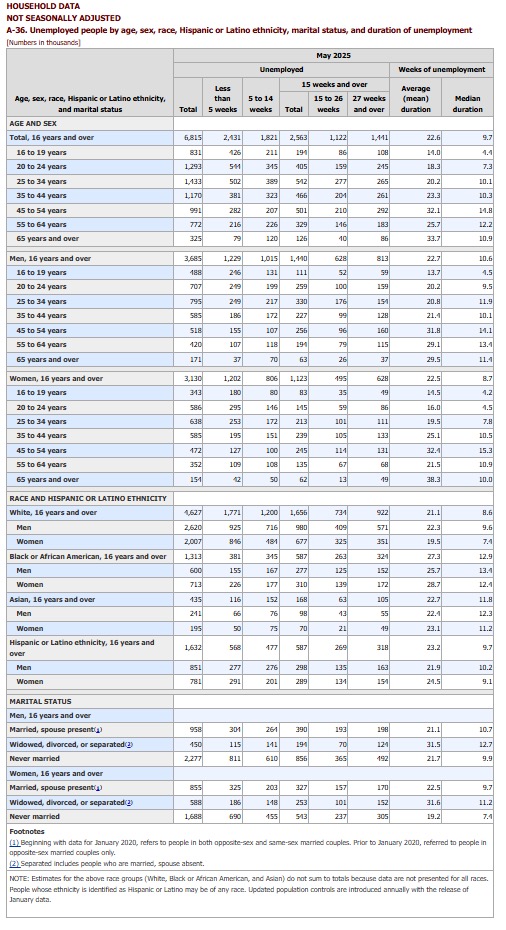
By Industry
The Conference Board Employment Trends Index (ETI) decreased to 107.49 in May, compared to an upwardly revised 108 in April. According to index data, the decline was driven by negative contributions from four of its eight components: Percentage of Respondents Who Say They Find “Jobs Hard to Get,” Number of Employees Hired by the Temporary-Help Industry, Initial Claims for Unemployment Insurance and Job Openings.
“The ETI continued to slow relative to the start of 2025, but despite general tariff wariness, the ETI is currently above the 2017-19 average, suggesting that the labor market broadly remains on solid footing,” says Mitchell Barnes, economist at The Conference Board.
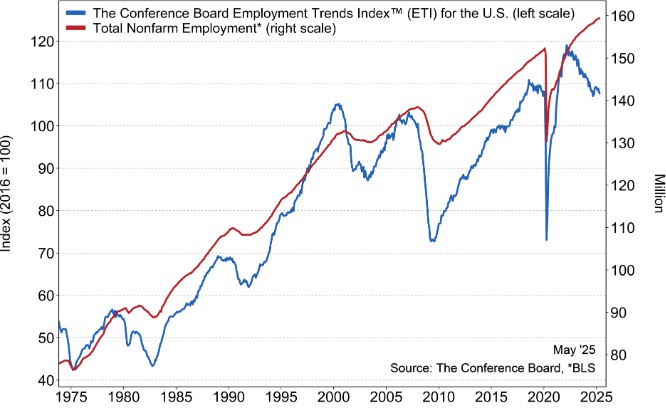
Caption: The Employment Trends Index is a leading composite index for payroll employment. When the Index increases, employment is likely to grow as well, and vice versa. Turning points in the Index indicate that a change in the trend of job gains or losses is about to occur in the coming months.
Data shows initial claims for unemployment insurance (an ETI component) climbed to 235,000 in May—the highest level since July 2024. In addition, the share of consumers who report “jobs are hard to get”—an ETI component from the Consumer Confidence Survey—increased in May to 18.6%, rising for the fourth consecutive month and matching its 2024 high. The share of small firms that report jobs are “not able to be filled right now” remained at 34% in May, which marks the lowest share since September.
“While uncertainty may be weighing on business and consumer confidence, May employment data indicated that hiring continued to keep the labor market roughly in balance,” Barnes says. “However, we are beginning to see some sector erosion that could suggest emerging pressures from tariff shifts.”
- Employment in the temporary-help industry fell by 20,200 in May’s Employment Report, which otherwise showed the labor market holding steady. Temporary-help payrolls in 2025 have declined four out of five months, losing a total of 41,600 workers.
- The share of involuntary part-time workers declined modestly in May to 17%, down from a recent high of 18% in February, but remained above the 2024 average.
- Job openings rose in April data, but job openings are likely to decline in May’s report, consistent with Help-Wanted-OnLine job posting data.
“Pessimism about the labor market among firms and consumers did not translate to widespread weakening through May. Even as trade-exposed sectors and the broader economy brace for anticipated tariff impacts, the high rate of employment and elevated wage growth provide a buffer,” Barnes says.
Important Takeaways, Courtesy of the U.S. Bureau of Labor Statistics:
- Health care added 62,000 jobs, higher than the average monthly gain of 44,000 over the past 12 months. Job gains occurred in hospitals (+30,000), ambulatory health care services (+29,000) and skilled nursing care facilities (+6,000).
- Employment in leisure and hospitality continued to trend up (+48,000), largely in food services and drinking places (+30,000).
- Social assistance employment continued to rise (+16,000), reflecting continued growth in individual and family services (+16,000).
- Federal government employment continued to decline in May (-22,000), down by 59,000 since January. (Employees on paid leave or receiving ongoing severance pay are counted as employed in the establishment survey.)
Click here to review more employment details.



